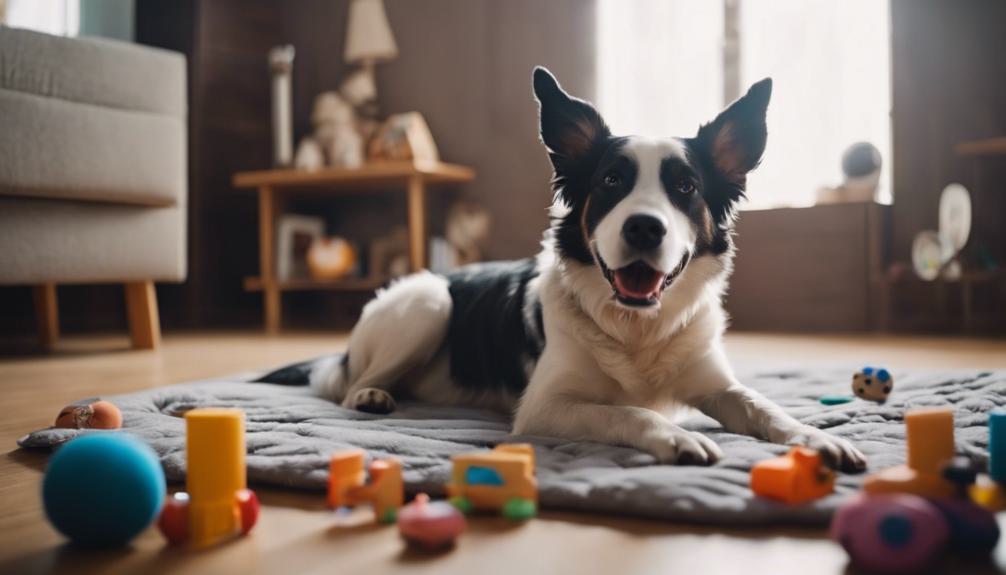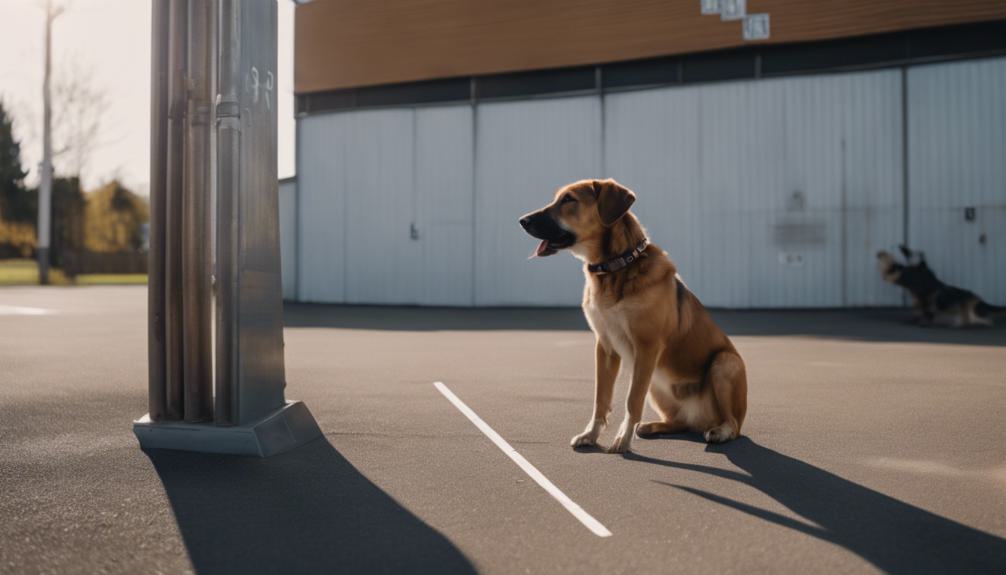How to Train a Territorial Dog? Keeping the Peace Tips
To train a territorial dog, understand triggers like fear and natural instincts. Establish clear rules and consistent boundaries to lead. Use treats and praise for positive reinforcement. Redirect focus from triggers with obedience commands and games. Manage urine marking by rewarding appropriate behavior. Create a secure living space with structure. Socialize early and include diverse experiences. Modify behavior with desensitization and rewards. Deal with aggression by identifying triggers and using calming techniques. Stay consistent and patient, rewarding progress. Additional strategies await for better training results.
Understanding Territorial Behavior
What causes a dog to act territorially?
Territorial behavior in dogs usually stems from fear, protectiveness, and natural guarding instincts. Dogs that have experienced trauma, like those from shelters, may display fear-based aggression, leading to territorial behavior. Certain breeds, such as Akitas and Doberman Pinschers, often feel threatened by strangers or unfamiliar animals, triggering their protective instincts. Identifying these triggers is crucial for managing your dog’s behavior effectively.
To help your dog become less reactive to perceived threats, use desensitization and counter-conditioning techniques. These methods make the dog feel safer and more relaxed. By understanding and working with your dog’s instincts, you create a more secure environment for your pet.
Establishing Leadership and Boundaries
Set clear rules and consistent boundaries to establish your leadership with your territorial dog. Providing structure and guidance helps your dog learn their place in your family’s hierarchy.
Use treats and praise as positive reinforcement to strengthen your role as leader, avoiding aggression. It’s important to be consistent with these rules to keep territorial behaviors from getting worse.
Avoid confrontational behavior to prevent triggering your dog’s territorial instincts. Creating a secure environment with well-defined boundaries makes your territorial dog less likely to feel the need to protect their space.
Positive Reinforcement Training Techniques

To address your dog’s territorial behavior, use positive reinforcement training techniques. Reward your dog with high-value treats like chicken or cheese when they exhibit calm, non-aggressive behavior. This method helps create positive associations.
Incorporate clicker training to mark and reward the right responses to territorial triggers. Develop a clear and achievable training plan to systematically reduce territorial behavior.
Be patient and consistent with your training, slowly desensitizing your dog to known triggers in a controlled setting. Using positive reinforcement, high-value treats, and clicker training can significantly improve your dog’s behavior.
Redirecting Territorial Triggers
To manage your dog’s territorial triggers effectively, follow these straightforward steps using positive reinforcement:
- Shift your dog’s focus from trigger stimuli by engaging them in obedience commands.
- Distract your dog in triggering situations with interactive games.
- Reward calm behavior with treats or praise to reinforce positive reactions to territorial triggers.
- Expose your dog gradually to trigger stimuli in controlled environments to desensitize them.
- Seek guidance from a professional trainer to develop a personalized plan if needed.
These methods help create a focused and calm environment for your dog, reducing stress and improving behavior.
Managing Urine Marking Behavior

To tackle your dog’s urine marking behavior, promptly clean up any marked spots. This helps prevent the scent from encouraging repeat behavior.
Use positive reinforcement when your dog urinates in appropriate places. Offer treats or praise to teach them where it’s acceptable to go.
Monitor your dog closely for signs they might mark, especially when new people or objects come into your home.
Understanding why your dog marks and consistently managing this behavior is crucial. By doing these things, you can control this common territorial response effectively.
Create designated areas in your home where your dog can move freely and comfortably. To foster a shared living space that aids in training and reduces territorial behaviors, follow these practical steps:
- Install baby gates or barriers to restrict access to specific rooms or areas.
- Provide your dog with a secure and cozy spot, such as a crate or bed.
- Ensure your dog has everything they need, including food, water, toys, and a designated bathroom spot.
- Set a regular schedule for feeding, walking, and playtime to give your dog structure.
- Use daily interactions for basic obedience training to promote good behavior and prevent territorial issues.
These methods help maintain a harmonious home where both you and your dog can thrive.
Importance of Socialization

Socialize your territorial dog early to shape their behavior and ease interactions. Early exposure to different people and animals helps prevent fear-based aggression and unwelcome territorial habits. Include various environments, sounds, smells, and stimuli in their daily experiences.
Positive interactions during their critical socialization period are crucial. A lack of proper socialization can increase anxiety and aggression. By dedicating time to socialize your dog, you pave the way for a balanced and confident companion.
Behavior Modification Strategies
To modify your territorial dog’s behavior effectively, consider using desensitization and counter-conditioning techniques. These methods gradually help your dog react differently to triggers.
Here are practical strategies to assist you:
- Reward your dog’s calm behavior with treats or praise to reinforce positive actions. This redirects their focus away from territorial responses.
- Avoid punishing your dog for territorial behavior, as this can lead to increased fear and aggression.
- Collaborate with a professional trainer or veterinary behaviorist to create a personalized behavior modification plan that suits your dog’s specific needs.
Remember, being consistent and patient is crucial when training your territorial dog to adopt more appropriate behaviors.
These steps provide a clear and practical approach to modifying territorial behavior in dogs.
Dealing With Territorial Aggression

To tackle territorial aggression in dogs, it’s crucial to first identify what triggers this behavior. Common signs include barking, growling, lunging, and biting when they feel their space is invaded.
Early socialization and training play key roles in reducing these aggressive tendencies. Avoid punishing your dog for aggressive reactions, as this can lead to more fear and anxiety. Instead, employ training methods like desensitization and counter-conditioning. These techniques help your dog react more calmly to perceived threats, ensuring a safer environment for everyone.
Consistent application of these strategies is essential for success. By understanding and addressing these behaviors effectively, you can help your dog behave better around others.
Maintaining Consistency and Patience
Are you training a territorial dog? Maintaining consistency and patience is crucial. Consistency reinforces good behavior and helps manage territorial instincts. Patience is necessary because changing behavior takes time. Repeating training exercises helps dogs learn new behaviors. Establishing a routine can reduce a dog’s anxiety and improve training results. Reward small successes to encourage your dog.
To keep consistent and patient, follow a set training schedule, reward good behavior, and control your reactions to territorial behaviors.
Training a territorial dog demands dedication, time, and a calm approach. By staying consistent, patient, and rewarding positive actions, your dog can adjust and succeed.
Frequently Asked Questions
Can You Train a Dog Not to Be Territorial?
You can train a dog not to be territorial through consistent obedience training and positive reinforcement. Teaching basic commands like ‘sit,’ ‘stay,’ and ‘leave it’ redirects territorial behaviors. Desensitization and counter-conditioning techniques can help change responses.
How Do You Break a Dog’s Territorial Aggression?
To break a dog’s territorial aggression, start with desensitization and counter-conditioning. Gradually expose your dog to triggers, like people passing by, using control techniques such as sitting and rewarding good behavior. Avoid punishment to prevent increased anxiety.
How Can I Make My Dog Less Territorial at Home?
To make your dog less territorial at home, identify triggers and use desensitization techniques. Create a safe space for them to feel secure. Provide mental and physical stimulation. Consult a professional for personalized guidance and a training plan.
Why Is My Dog Getting so Territorial?
Your dog may be getting territorial due to fear, protectiveness, or breed tendencies. Grasping these underlying reasons is essential. Addressing these issues early can prevent aggression. Training and managing your dog with care is key.
Conclusion
To train a territorial dog effectively, you need to be consistent, patient, and firm. Set clear boundaries, use positive reinforcement, and redirect behavior when triggers appear.
Introduce your dog to various social situations to lessen aggressive territorial reactions. Training involves behavior modification techniques that are critical for success.
Stay dedicated and informed, and you’ll see your dog become more well-mannered and content.

